Retinoid Recommendation Tool
Find Your Perfect Retinoid
Answer three simple questions to get personalized recommendations for retinoid products based on your skin goals, tolerance, and budget.
If you’re hunting for smoother skin, Retino A Cream 0.05% is often the first name that pops up. But the world of retinoids is crowded - from prescription‑strength tretinoin to over‑the‑counter retinol serums. Wondering which one actually gives you the glow without the drama? This guide breaks down Retino A Cream side‑by‑side with the most common alternatives, so you can decide what fits your routine and budget.
Key Takeaways
- Retino A Cream 0.05% (tretinoin) is the most potent prescription retinoid, excellent for acne and deep‑line reduction but can cause significant irritation.
- Adapalene (e.g., Differin Gel) offers similar acne benefits with a lower irritation profile, suitable for beginners.
- Tazarotene is the strongest prescription option, best for stubborn psoriasis and severe acne, but it dries the skin quickly.
- Retinol and retinol‑based serums are non‑prescription, milder, and cost‑effective for gradual anti‑aging.
- Cost, prescription requirement, and skin tolerance are the three decisive factors when choosing a retinoid.
What is Retino A Cream 0.05%?
Retino A Cream is a pharmaceutical preparation that contains tretinoin at a concentration of 0.05%. Tretinoin, a derivative of vitaminA, was first approved by the FDA in 1971 for treating acne and later for photodamage. The cream format is designed for evening application, allowing the active ingredient to work overnight while the skin’s natural repair processes kick in.
How Tretinoin Works - The Science Behind the Glow
Tretinoin binds to retinoic acid receptors (RAR‑α,β,γ) inside skin cells. This binding triggers gene expression that speeds up cell turnover, stimulates collagen synthesis, and reduces melanin clumping. The result is smoother texture, faded hyperpigmentation, and fewer breakouts. However, the accelerated turnover can also strip the skin’s barrier, leading to redness, peeling, and increased sun sensitivity.
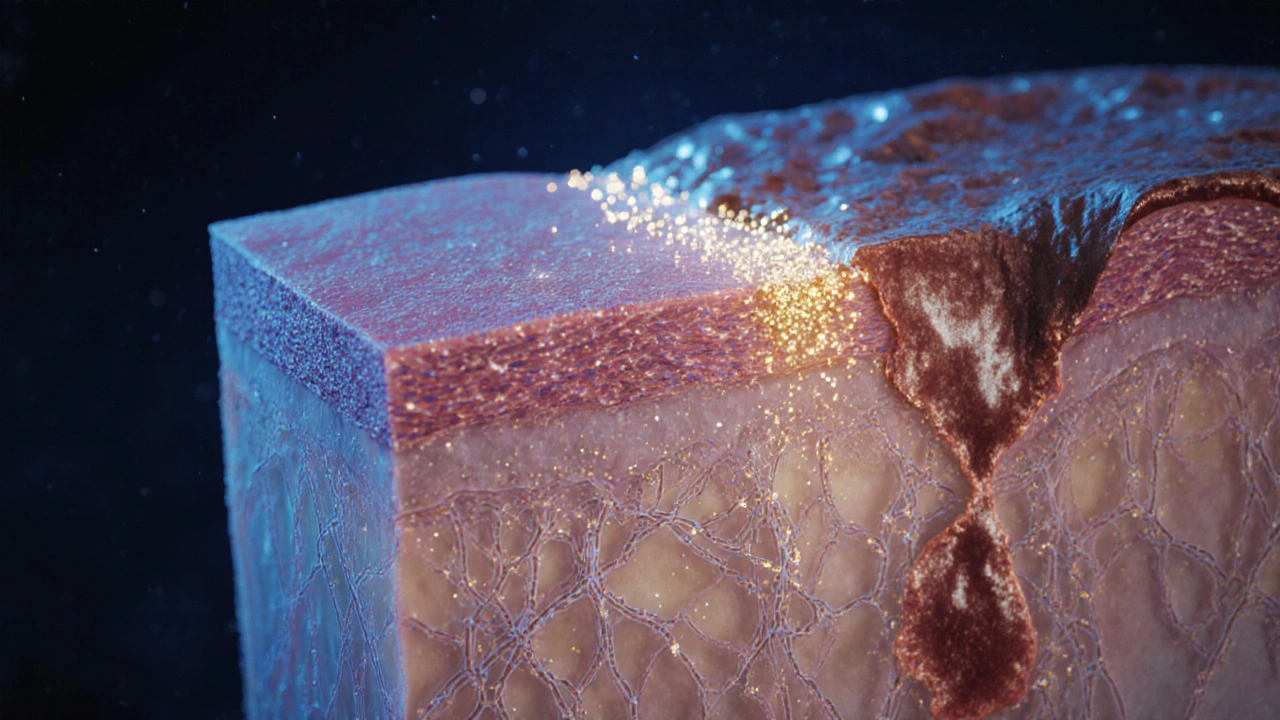
Top Alternative Retinoids
Not everyone can handle tretinoin’s potency, and some prefer a milder route. Below are the most widely used alternatives, each with its own strengths.
Adapalene (Differin Gel)
Adapalene is a synthetic retinoid approved for acne treatment. It is available over‑the‑counter in a 0.1% gel (brand name Differin Gel). Compared with tretinoin, adapalene has a slower binding affinity, which translates to less irritation while still normalising follicular keratinisation.
Tazarotene (Tazorac)
Tazarotene is a third‑generation retinoid, marketed under names like Tazorac and Avage. It is sold in 0.05% and 0.1% cream or gel forms and requires a prescription. Tazarotene is the strongest among the three, delivering rapid improvement in psoriasis plaques and severe acne, but it can be very drying.
Retinol (Over‑the‑Counter)
Retinol is the alcohol form of vitaminA. Unlike tretinoin, it must be converted by skin enzymes into the active retinaldehyde and then to tretinoin. This two‑step conversion makes retinol substantially gentler, ideal for beginners targeting fine lines and uneven tone.
Popular over‑the‑counter options include Skinceuticals Retinol and many boutique serums that combine retinol with soothing ingredients like niacinamide.
Other Notable Options
- Retin‑A Micro - micronized tretinoin, similar potency to Retino A but with a finer texture that some users find less irritating.
- Combined retinoid‑like complexes (e.g., bakuchiol) - plant‑derived alternatives that mimic some retinoid effects without binding to RARs.
Side‑Effect Profile Comparison
| Product | Prescription? | Typical Irritation Level | Common Side Effects | Sun Sensitivity |
|---|---|---|---|---|
| Retino A Cream 0.05% | Yes | High | Redness, peeling, dry patches | Significant |
| Adapalene (Differin Gel 0.1%) | No (OTC) | Medium | Mild irritation, occasional dryness | Moderate |
| Tazarotene 0.05% | Yes | High | Intense dryness, erythema, scaling | High |
| Retinol (1% serum) | No | Low‑Medium | Occasional mild redness, itching | Low‑Moderate |
| Retin‑A Micro 0.04% | Yes | Medium‑High | Peeling, dryness, occasional stinging | Significant |
Notice the pattern: the stronger the retinoid, the higher the irritation and sun‑sensitivity. If you’re new to retinoids, starting with adapalene or a low‑percentage retinol is a safer bet.
Cost and Accessibility
Cost can make or break a skincare habit. Below is a rough monthly expense based on typical UK pricing (as of October2025):
- Retino A Cream 0.05% - £45-£55 for a 30‑g tube (prescription reimbursement may lower out‑of‑pocket cost).
- Adapalene (Differin Gel) - £20-£25 for a 30‑g tube, available without a script.
- Tazarotene - £60-£80 for a 30‑g tube, prescription‑only.
- Retinol serums (1% or less) - £15-£40 depending on brand and concentration.
- Retin‑A Micro - similar pricing to RetinoA, around £50 for a 30‑g tube.
Remember that insurance coverage for prescription retinoids varies by NHS trust and private plans. Over‑the‑counter options are generally more affordable but may require longer timelines to see results.
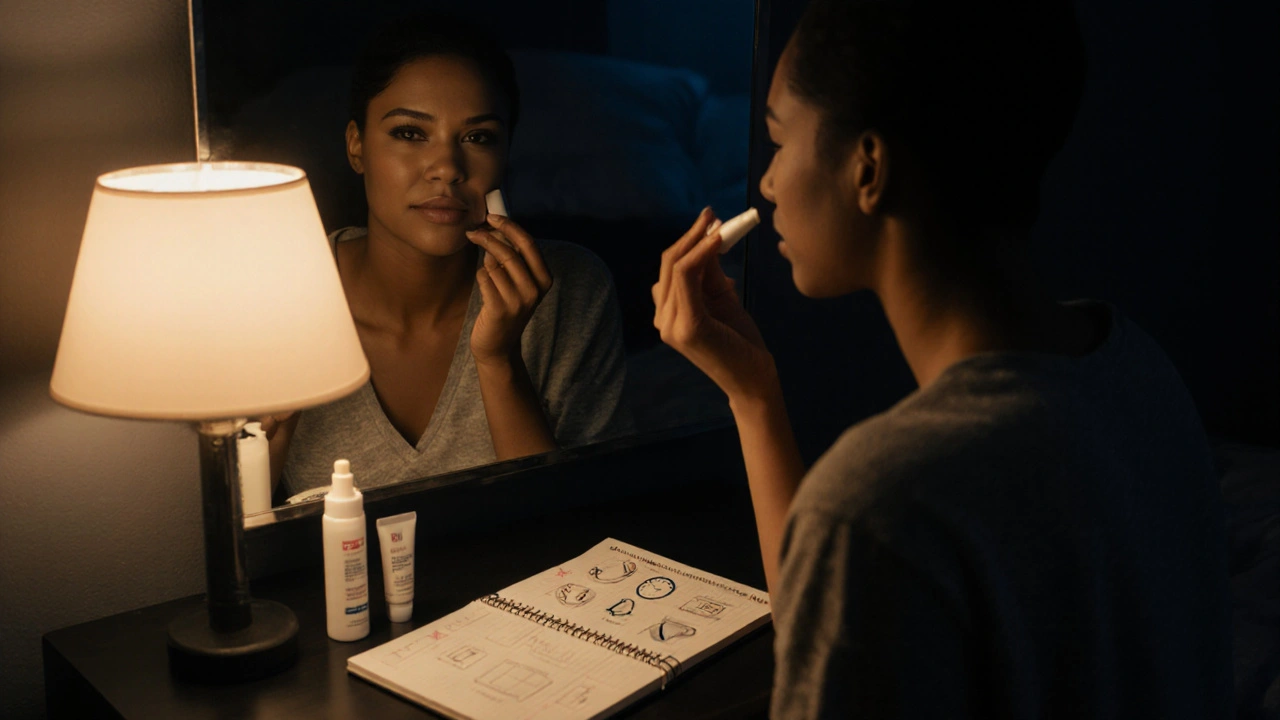
Choosing the Right Retinoid for Your Skin
Think of the decision as a three‑axis chart: potency, tolerance, and budget. Plot yourself on each axis and see where you land.
- Assess skin tolerance. If you’ve never used any retinoid, start with a 0.025% tretinoin or a 0.5% retinol serum. Add the product two to three times a week and observe.
- Define your primary goal. For active acne, adapalene or tretinoin are proven. For fine lines and photodamage, retinol or low‑dose tretinoin work well.
- Check prescription requirements. In the UK, tretinoin and tazarotene need a doctor’s script. If you can’t get one, adapalene or retinol are the next best options.
- Factor in cost. If you’re on a tight budget, a 0.5% retinol serum can deliver noticeable improvement over six months at a fraction of the price.
- Build a supporting routine. Pair any retinoid with a gentle cleanser, a hydrating moisturizer, and morning sunscreen (SPF30+).
By following these steps, you can avoid the classic “burn‑and‑breakout” saga that many newcomers experience.
Practical Checklist Before You Start
- Do a patch test on the jawline for 3days.
- Start with 2‑3 applications per week, night only.
- Layer a barrier‑repair moisturizer 15minutes after retinoid.
- Never skip sunscreen during the day.
- Monitor for >10% increase in redness or peeling - if it happens, cut back frequency.
Frequently Asked Questions
Can I use Retino A Cream and adapalene together?
No. Both are retinoids and will amplify irritation. Choose one and stick with it, alternating only if a dermatologist advises a tapering schedule.
How long does it take to see results with Retino A Cream?
Most users notice smoother texture and reduced breakouts after 4‑6weeks, while deeper anti‑aging changes (fine line softening) can take 3‑6months of consistent use.
Is retinol safe during pregnancy?
Retinol and prescription retinoids like tretinoin are classified as CategoryC and should be avoided during pregnancy. Talk to your GP for safer alternatives.
What’s the biggest difference between tazarotene and tretinoin?
Tazarotene is chemically more potent and works faster on severe acne and psoriasis, but it also dries the skin more quickly. Tretinoin offers a balance of efficacy and tolerability for most users.
Can I use a retinoid and vitaminC together?
It’s best to separate them - vitaminC in the morning and retinoid at night - to minimise irritation and preserve the antioxidant’s stability.
Armed with this comparison, you can pick the retinoid that matches your skin’s needs, budget, and comfort level. Remember, consistency beats potency; even a gentle retinol applied nightly will out‑perform a night of missed tretinoin applications.
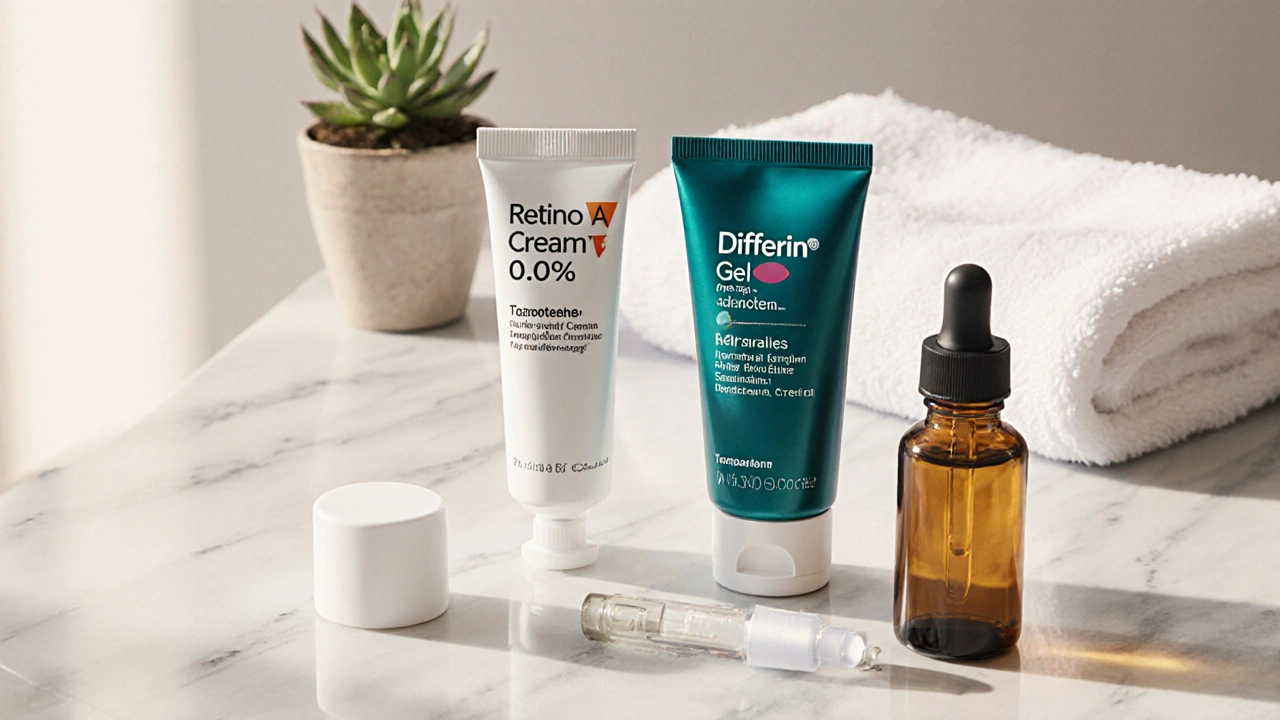


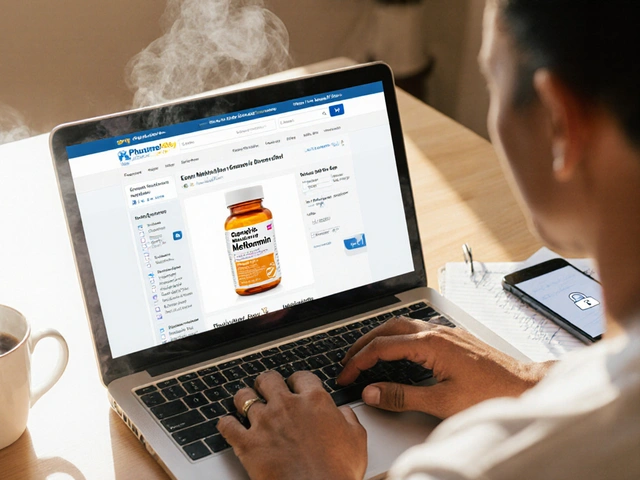
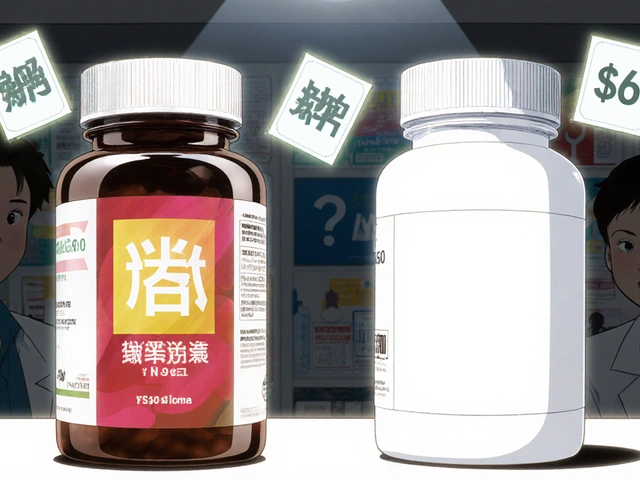



Posts Comments
Sudha Srinivasan October 12, 2025 AT 18:12
People keep treating retinoids like magic pills, ignoring the fact that they can wreak havoc on sensitive skin. If you cant handle a little dryness, you shouldn’t be playing with prescription strength.
Jenny Spurllock October 19, 2025 AT 16:13
It’s noteworthy how many skip the recommended moisturiser and sunscreen despite clear warnings. Consistency in a low‑frequency regimen often yields better tolerability than binge‑applying a strong retinoid. The data in the guide reinforces that restraint is key.
Bart Cheever October 26, 2025 AT 14:14
The article is thorough but needlessly verbose. A concise summary would serve readers better.
Maude Rosièere Laqueille November 2, 2025 AT 12:16
If you're new to retinoids, consider a 2‑3‑times‑per‑week schedule and pair it with a ceramide‑rich moisturizer. Start with a pea‑sized amount to avoid overwhelming the barrier. Gradually increase frequency as your skin builds tolerance. Remember to apply a broad‑spectrum SPF 30+ every morning, even on cloudy days.
Amanda Joseph November 9, 2025 AT 10:17
Wow, thanks for the poetry, really needed another lecture about dryness.
Kevin Aniston November 16, 2025 AT 08:19
Building a sustainable retinoid routine is less about chasing the biggest discount and more about respecting your skin's natural healing timeline.
First, anchor your regimen with a gentle, fragrance‑free cleanser that won’t strip away the lipids you’re about to replenish.
After cleansing, wait at least five minutes for the skin to dry, because damp skin can increase the penetration rate and amplify irritation.
Apply a pea‑sized portion of the retinoid to the forehead, chin, cheeks, and nose, avoiding the immediate eye area.
If you’re using Retino A Cream 0.05%, start with two nights a week and keep a journal of any redness, peeling, or itching you notice.
On the evenings you skip the retinoid, introduce a barrier‑supporting serum containing niacinamide or hyaluronic acid to keep moisture levels stable.
Morning after a retinoid night, follow up with a lightweight moisturizer that contains ceramides to help rebuild the skin barrier.
Finish the morning routine with a broad‑spectrum sunscreen of at least SPF 30, applying it liberally and reapplying every two hours if you’re outdoors.
Patience is essential; most users see noticeable texture improvement after four to six weeks, while deeper collagen remodeling can take three to six months.
If you experience more than ten percent increase in visible redness, pull back to once a week and give your skin a week to recover before increasing again.
Avoid using other potentially irritating actives like benzoyl peroxide or strong AHAs on the same night as your retinoid, unless a dermatologist has specifically advised you to do so.
When you feel confident with the frequency, you can consider layering a mild antioxidant serum in the morning to boost overall radiance.
Remember that consistency beats intensity; missing a few nights is okay, but a regular schedule yields the best long‑term results.
Also, keep in mind that lifestyle factors such as diet, sleep, and stress management play a supporting role in how your skin responds.
Finally, if cost is a concern, look for generic tretinoin creams that contain the same active ingredient at a lower price point.
Stay attentive, listen to your skin’s signals, and adjust as needed, and you’ll reap the benefits of a smoother, clearer complexion without the drama.
kiran kumar November 23, 2025 AT 06:20
i get it you think retinoids are evil but most people dont even know how to use them properly they end up overusing and blame the product
Alan Clark November 30, 2025 AT 04:21
It's exciting to see more affordable OTC options hitting the market; they give newcomers a chance to test retinoids without a prescription. With proper guidance, even a simple 0.5% serum can deliver noticeable glow over time. Keep an eye on how your skin reacts and adjust the strength gradually.
Write a comment